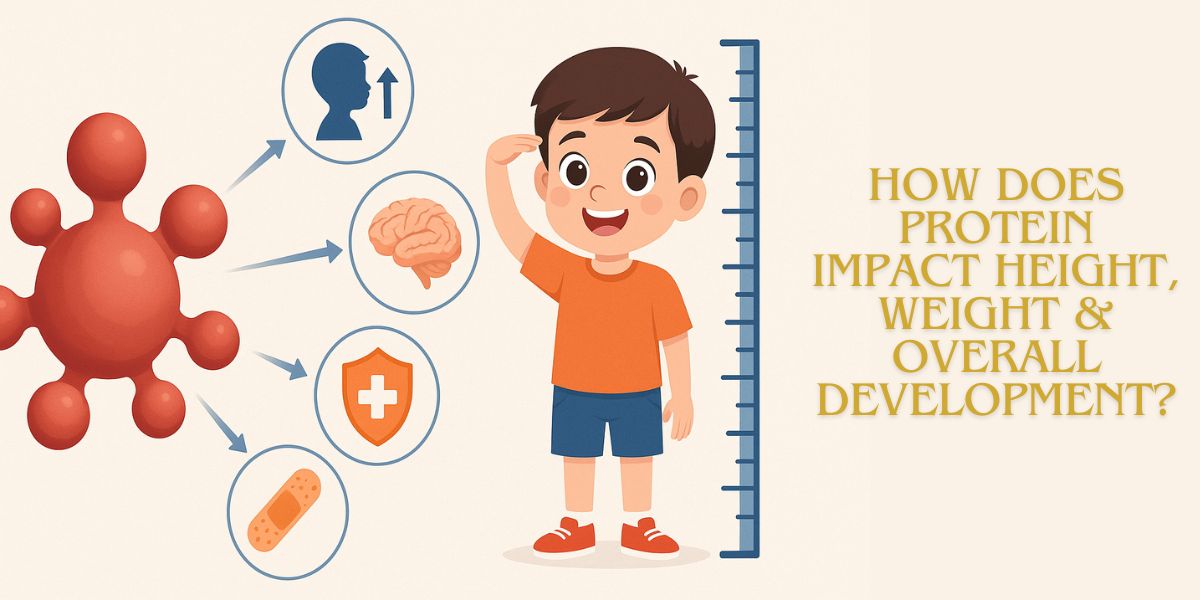
Table of Contents
Growth and development in children is always associated with protein intake. And rightly so, because protein for kids is one stand out macronutrient that builds the foundation for their physical and cognitive development.
Different types of amino acids act as building blocks to make various proteins. These amino acids are essential to support different biological functions in the body, especially during rapid growth spurts during childhood.
Amino acids can be classified into two categories that is essential and non-essential amino acids. Out of 20, there are 9 essential amino acids which cannot be made by the body and must be obtained through the diet. They are necessary for healthy growth and development.
1. Linear growth: protein helps in building height and weight through bone development.
2. Brain Development: protein helps in making neurotransmitters which support cognitive function.
3. Building Immunity: protein promotes formation of antibodies to promote the immune response.
4. Wound Healing: protein plays an important role in tissue repair and regeneration and hence promotes wound healing.
Protein consists of an essential amino acid called tryptophan which helps in producing “Serotonin” also known as “The Happy Hormone” and can thus promote mood regulation in children.
Yes, absolutely. Multiple studies have highlighted the link between adequate protein for kids and height gain.
Secure enough protein for kids by including both animal sources like milk and milk products, eggs, meat, and fish; and plant-based sources like soy, pulses, legumes, and quinoa.
Not only calories but also the quality of nutrients provided determine weight gain in children. Evidence suggests that kids who have enough protein in their diets have better Body Mass Index (BMI) scores as compared to those who don’t.2
According to Indian Council of Medical Research, 2024; required amount of protein for kids are:
Age Group |
Protein Requirement (g/day) |
| 1-3 years | 12.5 |
| 4-6 years | 16.0 |
| 7-9 years | 23.0 |
| 10-12 years (Boys) | 32.0 |
| 10-12 years (Girls) | 33.0 |
As parents, you always want to ensure that your child is getting optimal nutrition. One of the integral components of securing a balanced diet is including complete protein for kids which provides all the essential amino acids for your child’s growth and development. This can be achieved by including diverse sources; both plant-based and animal-based sources in the diet. However, if your child is a fussy eater and is not able to meet the requirement through food, then you can include a nutritional drink like Complan.
Complan consists of 100% milk protein which has all the essential amino acids. The milk protein in Complan is also easily digestible and a single serve of Complan meets 25% of the protein RDA requirement for a 7–9-year-old child. Additionally, Complan has 63% more protein than other malt-based nutritional drink.
Hence, including Complan can support adequate intake of protein for kids which helps in growth and development.
1Xiong, T., Wu, Y., Hu, J., Xu, S., Li, Y., Kong, B., Zhang, Z., Chen, L., Tang, Y., Yao, P., Xiong, J., & Li, Y. (2023). Associations between High Protein Intake, Linear Growth, and Stunting in Children and Adolescents: A Cross-Sectional Study. Nutrients, 15(22), 4821. https://doi.org/10.3390/nu15224821
2Braun, K. V., Erler, N. S., Kiefte-de Jong, J. C., Jaddoe, V. W., van den Hooven, E. H., Franco, O. H., & Voortman, T. (2016). Dietary Intake of Protein in Early Childhood Is Associated with Growth Trajectories between 1 and 9 Years of Age. The Journal of nutrition, 146(11), 2361–2367. https://doi.org/10.3945/jn.116.237164
3National Institute of Nutrition. (2024). Short Summary of Recommended Dietary Allowances (RDA) and Estimated Average Requirements (EAR) – 2020. ICMR-NIN Expert Group on Nutrient Requirement for Indians. https://www.nin.res.in/RDA_short_Report_2024.html
4Endrinikapoulos, A., Afifah, D. N., Mexitalia, M., Andoyo, R., Hatimah, I., & Nuryanto, N. (2023). Study of the importance of protein needs for catch-up growth in Indonesian stunted children: a narrative review. SAGE open medicine, 11, 20503121231165562. https://doi.org/10.1177/20503121231165562
0%
You have clicked on a link which leaves Zydus wellness's website, and you will be redirected to a third party website. Zydus Wellness makes no representations nor has any supervision or control over the quality, content, reliability or security of the third party website, nor shall Zydus / its affiliate be responsible / liable for its use.